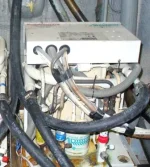Re: Marine Air Unit Sounds Like a Transformer…
There's a big diffrence between tying them together at a single point (the ground buss) and daisy chaining. The only way one unit makes another hot is if that common buss dis conects from ground (unlikely as it's tied in at several points). Remember most Hats have Iso transformers so when on shore power your not connected to shore ground your working entirely on a sea water ground. Each unit has it's own green ground wire and is not daisy chained for the same reason your bonds should have them.Your bonding circuit does not terminate at a zinc. It terminates at a ground plate or thru the thru hull fittings that are in the system. That's a path to ground. So if you have individual bonding wires going to a common buss (ground straps) A unit thats leaking finds ground thru the system without passing thru other equiptment. Yes you could have a situation were the ground straps break in to places then everthing tied in to them between the two breaks would be hot. But that's less likely than a single wire breaking off a daisy chain ground. Again something is better than nothing but the codes do make sense for the reasons stated above.
Brian
The Buss or Strap is just the common connection point...Basically a Strap is just a longer Buss, and individual wires need to be longer to get to a Buss that is further away than a centrally run strap might be.
What we are discussing here is current flow, connections & the common connection point to whatever (at least that's what I think we are discussing) and that Connections are subject to failure due to corrosion etc.
I'm not arguing against you Brian...Code...NEC, ABYC, or ABS practices...I understand the reasoning & follow them...I only suggested an easier way for Traveler to accomplish what he might want to do to protect his A/C units....It will work as we agree but yes, one connection could fail causing him to loose protection of more than one unit...My only contention here was & is that it (loss of connection) can still happen elsewhere in the system too, & suggest that neither of us know the condition, or specific routing of his particular installation.
Not all Hatt's have isolation transformers...and as you mentioned Some older Hatts don't have ground...As far as Traveler's 45C...He hasn't said either way, but I'm fairly sure his 45C does have ground at least.
Most bonding systems terminate at zinc...Usually a plate at the transom, or thru shaft brushes with shaft zincs & to rudder posts (rudders having zincs as well) or even all of the above...
As far as making other units "live"...That would first require a motor or device to leak lower current to ground than the breaker's rating that it is powered by...(yes that can happen)
A dead short would draw more current than the breaker was rated for, and thus cause the breaker to disconnect/trip that circuit...Unless as you point out, it's connection to ground is not there...
Some Hatt's even had GFI main breakers installed that would trip with a small percentage of stray current leaking.
I have mainly been speaking of odds of connection & equipment failure...And I Agree with you Brian that there is always a Right way to do things...Also that it would depend on the individual situation given the present condition of what is existing & owners budget...Often bringing things up to code is just not in the cards...
Many of the boats we speak of here were obviously not built to current code, but Hatteras has always been the best at MEP installation/layout (most times better than code) of any production builder's boats I have worked on in my 30 some years in the Marine industry....I also suggest that thru the years a boat's original installation has likey changed somewhat from the many hands that have passed over it...
Traveler 45C~
However you do it...Please bond/ground your A/C to protect against it's solder joint deterioration...
Merry Christmas Everyone,
Steve~


